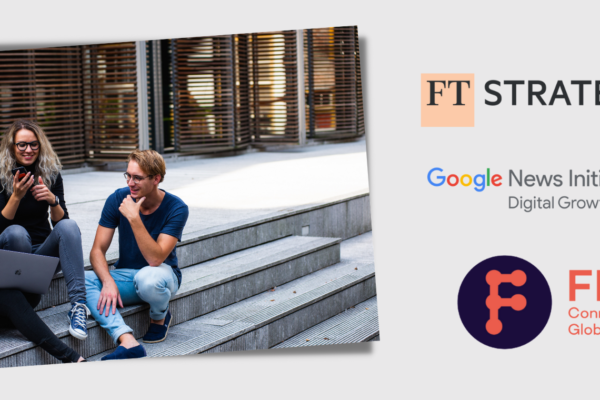Google Digital Immersion Week: Talking Transformation
As publishers embark on their individual digital transformation journeys, the stakes have never been higher. Get things right and your secure the sustainability of newsrooms and quality journalism. Get it wrong, and publications face a deepening existential crisis.
To help guide publishers, FIPP and FT Strategies, the subscriptions consultancy from the Financial Times, joined forces for the inaugural Digital Immersion Week – a five-day course for operational managers in magazine media in Europe, the Middle East and Africa, that featured invaluable insights from brands that have made a successful digital shift.
Speaking on the opening day, John Slade, Chief Commercial Officer responsible for subscription consumer business at the Financial Times, highlighted the importance of publishers making changes across the board to survive.
“We need multiple strategies for each section of the business that ensure we’re still retaining maximum profitability – it’s a glide path, not a sudden shift in gears,” he said. “It’s about securing multiple engines for the airplane.
“We know that our old engines won’t sustain us in the air forever, so new engines in great working order are necessary. The Covid crisis has brought forward the trajectory and horizon for the news industry by around two years and sustainable newsrooms are not guaranteed.”
There are some sobering figures to back up Slade’s warning. Print advertising is less than half what it was for all newspapers just 10 years ago, a decline of many billions in revenue for news organisations. The US newspaper industry has seen a fall from a peak of US $70 billion dollars in advertising revenue in the year 2000 to US $15 billion in 2019 – an 80 per cent fall in under two decades. In the last 12 years newsroom employees in the US have fallen from 70,000 to under 35,000.
It’s the same journalism that the customers have always paid for in print […] so as a matter of principle, why shouldn’t we charge for it online?
John Slade
Leading the way
Over the last 15 years or so, The Financial Times has delivered a masterclass in how to undergo digital transformation. A pioneer in paid online content, the brand has raked in 1.3 million loyal, engaged subscribers across the FT group. It now makes more money in digital than in print and more from readers than advertisers – two vital signs of sustainability.
“Reader revenue is not a ‘nice to have’ it is a must have,” said Slade. “We are occupied with a business of putting our future in our own hands and that means building a quality business with recurring revenue streams that are largely immune from wider economic conditions.
“The economics of all three traditional sources of revenue are very tough. But reader revenue, from subscriptions in our case, is a less challenged area of the industry. The model faces its own challenges – share of wallet competition, finding sufficient resources to invest and fast, internal and customer attitudes – but it’s achievable and a financially rewarding mountain to climb.”
The FT achieved its success by breaking up its digital transformation journey into three phases. The ‘Mindset Phase’, from 2005-2015, was all about taking the plunge and having the confidence to charge for quality journalism online, something that at the time was largely unheard of.
“At the core of our thinking was, it’s the same journalism that the customers have always paid for in print – in fact, better because its interactive – so as a matter of principle, why shouldn’t we charge for it online?” said Slade.
“It was about having a mindset, to educate readers on the need to do it and showing them the value in them paying, by ensuring our journalism investments deliver outstanding content. And it was about a mindset of confidence to take ownership of our assets and start to sell directly to both corporate and individual customers.
“We removed our journalism from intermediaries and aggregators and arrived at our first strategic principle, one that still holds true today. To build a successful business, we need a direct relationship with our customers and that formed and still forms the core of our thinking around how we interact with today’s intermediaries Apple, Facebook and Google.”
A further mindset change was necessary in the FT’s internal cultures since it now regards its principal customer as the reader not the advertiser. That meant taking steps like ensuring reading experiences were optimised before advertising experiences, fewer ad units on a page, and a focus on page load speed and customer privacy.
Everything should be in play, everything should be on the table and that’s the best mindset.
John Slade
“Perhaps most importantly, in regard to internal mindset and cultural change, we have assimilated a third leg of the stool to our senior decision making process, but actually at all levels within the business,” said Slade. “Technology is not a supplier of service to the business, it’s an equal partner with editorial and the business side. Technology is a major competitive advantage.”
Phase two, the “Skills Phase” from 2015-2020, saw the development of significant internal skillsets in data analytics, pricing, marketing, technology, UX, product and editorial.
“I can’t put an accurate number on it, but I would say that at very least half of the skills in use the FT on a day-to-day basis today did not exist in our company a decade ago,” Slade pointed out. “New skills are necessary.
“Publishers selling subscriptions need to think and act as much like retailers, as they do media businesses. So look outside the publishing business to find those skills and remove any blinkers about who can provide inspiration and talent, but also don’t forget that talent can live within your existing business, if you provide the right motivation opportunities and investment to change.”
FT is currently in the ‘Mission Phase’, which Slade described as “recognising that we are a mature business with direct relationships, but that we now need to act in a way that is greater than the sum of our parts.”
“We conducted an assessment of where we were as a digital subscription business and indeed whether we could legitimately call ourselves one,” he added. “We’ve got work to do, and we think we can only do it by structuring ourselves in such a way that collaboration is the naturally arrived at focus of our efforts.
“We already excel at locally optimising different parts of our business, but now we want to accelerate our ability to make step change innovations that span the company. So ‘missions’ – autonomous, cross-functional, cross departmental teams working on vital areas of the business – are the logical response.”
The FT has launched three missions this year, one based around acquiring and activating new customers, one based around engaging and retaining customers and one based around transforming the tools they need to do the job.
Following the North Star
At the heart of the FT’s success has been its North Star Metric (NSM), which the company uses as a focus for its growth. This number best reflects the amount of value the company brings to its customers. For the FT, keeping users engaged and offering value is what really matters.
According Tim Part, Senior Manager at FT Strategies and resident expert in North Star, publishers should keep an open mind when building their own North Star. “The most important thing to remember is that North Star is this vehicle for ambition and exploring bigger ideas,” he explained during another session at the Digital Immersion Week. “So it shouldn’t be thought of as just another way of doing a business plan.
It’s a glide path, not a sudden shift in gears.
John Slade
“What this offers us is a chance to be more ambitious, be a bit different and a chance to really embrace what the future holds for you. At the beginning, come at it with an open mind. Everything should be in play, everything should be on the table and that’s the best mindset.
“The way we have built our structures to manage the whole North Star process is a reflection of our individual structure internally and how we best think a structure can be built to reflect the principles that a North Star governance structure has to maintain. Those principles are universal.
“It’s about transparency, accountability, about encouraging and a culture of experimentation. Those kinds of things those don’t change but practically how you build structures and processes and committees and groups to enable those things will be unique.”










